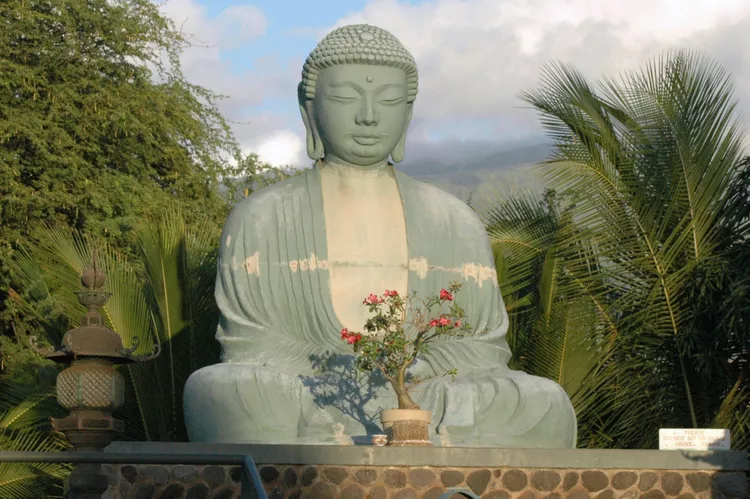Overview of Lahaina Jodo Mission
Many people who visit the island of Maui make it a point to explore the historic whaling town of Lahaina. Much of their exploration, however, is confined to the waterfront areas and the historic sites nearby.
Lahaina Jodo Mission
Located away from downtown Lahaina to the north on Ala Moana Street, the Lahaina Jodo Mission stands out as one of the most beautiful and serene places in Hawaii that should not be overlooked.
Years ago, members of the Lahaina Jodo Mission envisioned building an authentic Buddhist Temple with the symbolic surroundings typical of the great Buddhist temples in Japan.
The great Buddha and the Temple Bell were completed in June 1968, in commemoration of the Centennial Celebration of the first Japanese immigrants to Hawaii. In 1970, with generous support from the members of the mission and the general public, the main Temple and Pagoda were constructed.
The property is owned by the Lahaina Jodo Mission, and the maintenance and improvement of the premises rely on voluntary contributions.
The Temple

The temple is located on Puunoa Point, Lahaina, overlooking the islands of Molokai, Lanai, and Kahoʻolawe. The Lahaina Jodo Mission features a distinct Buddhist temple with unique architectural structures. The old wooden temple that once stood on the site burned down in 1968, and the new structure, completed in 1970, reflects the authentic traditions of ancient Japan.
One remarkable feature is the solid copper shingles covering the roofs of both the temple and pagoda. Each shingle was hand-formed and interlocked on all four sides, creating an impressive copper sheathing.
Paintings of Hajin Iwasaki
Inside the temple, five outstanding Buddhist paintings adorn the walls. Created in 1974 by Hajin Iwasaki, a noted Japanese artist, these artworks significantly enhance the temple’s ambiance. Additionally, floral ceiling paintings were added by the same artist in later years.
The Great Buddha

The statue of the Amida Buddha is the largest of its kind outside Japan. It was cast in Kyoto, Japan during 1967-1968. Made of copper and bronze, it stands 12 feet high and weighs approximately three and a half tons.
The Great Buddha was completed in June 1968, coinciding with the Centennial Celebration commemorating the immigration of the first Japanese to Hawaii 100 years prior.
The Pagoda

The Pagoda, or Temple Tower, reaches about 90 feet high at its tallest point, with a roof made of pure copper. Inside, the first floor contains niches designed to hold the urns of loved ones, along with a small altar.
The original term for “pagoda” in Sanskrit was “stupa.” The story behind it involves the cremation of Buddha’s body at Kusinara Castle under the supervision of Ananda, the Buddha’s favorite disciple. The King of Kusinara initially refused to distribute the ashes, which caused a conflict among neighboring rulers, but ultimately, under wise counsel, the ashes were divided and buried beneath eight great stupas. Consequently, the followers began to worship the pagoda, considering it a spiritual representation of the great Buddha.
The Temple Bell

This is the largest temple bell in the State of Hawaii, made of bronze and weighing approximately 3,000 pounds. On one side (the ocean side), it features Chinese characters stating, “Imin Hyakunen No Kane,” which translates to “The Centennial Memorial Bell for the First Japanese Immigrants to Hawaii.”
On the opposite side, the bell bears the phrase “Namu Amida Butsu,” which is the Jodo prayer. Additionally, small engraved characters list the names of many donors, both living and deceased, who have generously contributed their time and resources to the mission and to the completion of the Bell Tower.
Evening Rings
At the Lahaina Jodo Mission, this bell rings eleven times each evening at 8 o’clock.
The first three rings symbolize the following:
I go to the Buddha for guidance; I go to the Dhamma (the teachings of the Buddha) for guidance; I go to the Sangha (Brotherhood) for guidance.
The subsequent eight rings represent the Eight-Fold Pathway to Righteousness:
Right Understanding; Right Purpose; Right Speech; Right Conduct; Right Livelihood; Right Endeavor; Right Thought; and Right Meditation.





